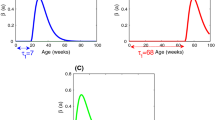Abstract
An SEIR model with periodic coefficients in epidemiology is considered. The global existence of periodic solutions with strictly positive components for this model is established by using the method of coincidence degree. Furthermore, a sufficient condition for the global stability of this model is obtained. An example based on the transmission of respiratory syncytial virus (RSV) is included.
Similar content being viewed by others
References
M.R. Al-Ajam, A.R. Bizri, J. Mokhbat, J. Weedon, L. Lutwick: Mucormycosis in the Eastern Mediterranean: a seasonal disease. Epidemiol. Infect. 134 (2006), 341–346.
R.M. Anderson, R.M. May: Population biology of infectious diseases, Part 1. Nature 280 (1979), 361.
R.M. Anderson, R.M. May: Infectious Diseases of Humans, Dynamics and Control. Oxford University, Oxford, 1991.
A. J. Arenas, G. Gonzalez, L. Jódar: Existence of periodic solutions in a model of respiratory syncytial virus RSV. J. Math. Anal. Appl. 344 (2008), 969–980.
O. Diekmann, J.A. P. Heesterbeek, J.A. J. Metz: On the definition and the computation of the basic reproduction ratio R 0 in models for infectious diseases in heterogeneous populations. J. Math. Biol. 28 (1990), 365–382.
O. Diekmann, J.A. P. Heesterbeek: Mathematical Epidemiology of Infectious Diseases: Model Building, Analysis and Interpretation. John Wiley & Sons, Chichester, 2000.
P. van den Driessche, J. Watmough: Reproduction numbers and sub-threshold endemic equilibria for compartmental models of disease transmission. Math. Biosci. 180 (2002), 29–48.
D. J.D. Earn, J. Dushoff, S.A. Levin: Ecology and evolution of the flu. Trends in Ecology and Evolution 17 (2002), 334–340.
M. Fan, K. Wang: Periodicity in a delayed ratio-dependent predator-prey system. J. Math. Anal. Appl. 262 (2001), 179–190.
R.E. Gaines, J. L. Mawhin: Coincidence Degree, and Nonlinear Differential Equations. Springer, Berlin, 1977.
J.K. Hale: Ordinary Differential Equations. Wiley-Interscience, New York, 1969.
G. Herzog, R. Redheffer: Nonautonomous SEIRS and Thron models for epidemiology and cell biology. Nonlinear Anal., Real World Appl. 5 (2004), 33–44.
H.W. Hethcote: The mathematics of infectious diseases. SIAM Review 42 (2000), 599–653.
L. Jódar, R. J. Villanueva, A. Arenas: Modeling the spread of seasonal epidemiological diseases: Theory and applications. Math. Comput. Modelling 48 (2008), 548–557.
Y. Li, Y. Kuang: Periodic solutions of periodic delay Lotka-Volterra equations and Systems. J. Math. Anal. Appl. 255 (2001), 260–280.
M.Y. Li, J. S. Muldowney: Global stability for the SEIR model in epidemiology. Math. Biosci. 125 (1995), 155–164.
W. London, J.A. Yorke: Recurrent outbreaks of measles, chickenpox and mumps. 1. Seasonal variation in contact rates. Am. J. Epidemiol. 98 (1973), 453–468.
J. Ma, Z. Ma: Epidemic threshold conditions for seasonally forced SEIR models. Math. Biosci. Eng. 3 (2006), 161–172.
M. Nuño, Z. Feng, M. Martcheva, C.C. Carlos: Dynamics of two-strain influenza with isolation and partial cross-immunity. SIAM J. Appl. Math. 65 (2005), 964–982.
Z. Teng: On the periodic solutions of periodic multi-species competitive systems with delays. Appl. Math. Comput. 127 (2002), 235–247.
Z. Teng, L. Chen: Permanence and extinction of periodic predator-prey systems in a patchy environment with delay. Nonlinear Anal., Real World Appl. 4 (2003), 335–364.
A. Weber, M. Weber, P. Milligan: Modeling epidemics caused by respiratory syncytial virus (RSV). Math. Biosci. 172 (2001), 95–113.
X. Zhang, L. Chen: The periodic solution of a class of epidemic models. Comput. Math. Appl. 38 (1999), 61–71.
T. Zhang, J. Liu, Z. Teng: Stability of Hopf bifurcation of a delayed SIRS epidemic model with stage structure. Nonlinear Anal., Real World Appl. 11 (2010), 293–306.
J. Zhang, Z. Ma: Global dynamics of an SEIR epidemic model with saturating contact rate. Math. Biosci. 185 (2003), 15–32.
T. Zhang, Z. Teng: On a nonautonomous SEIRS model in epidemiology. Bull. Math. Biol. 69 (2007), 2537–2559.
Author information
Authors and Affiliations
Corresponding author
Additional information
This work was supported by the National Natural Science Foundation of P.R.China (11001215, 10961022, 11101323).
Rights and permissions
About this article
Cite this article
Zhang, T., Liu, J. & Teng, Z. Existence of positive periodic solutions of an SEIR model with periodic coefficients. Appl Math 57, 601–616 (2012). https://doi.org/10.1007/s10492-012-0036-5
Received:
Published:
Issue Date:
DOI: https://doi.org/10.1007/s10492-012-0036-5




